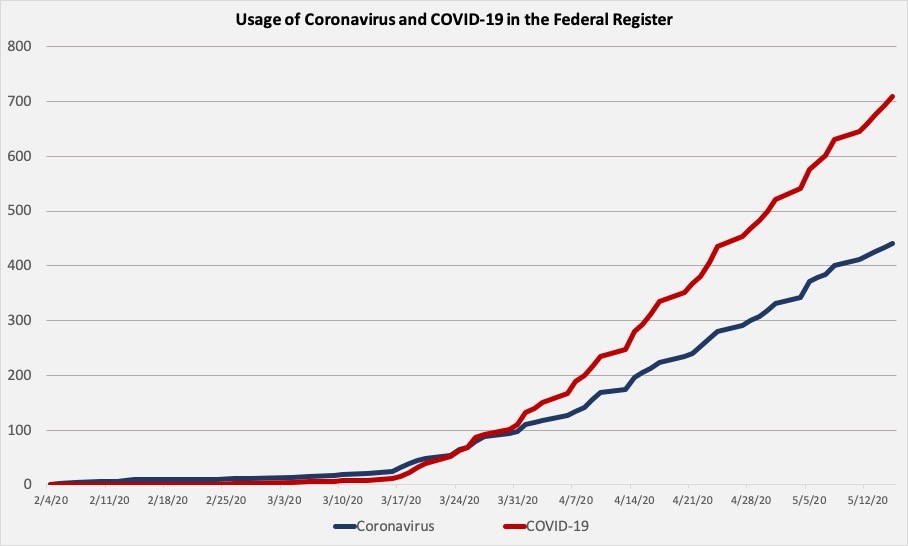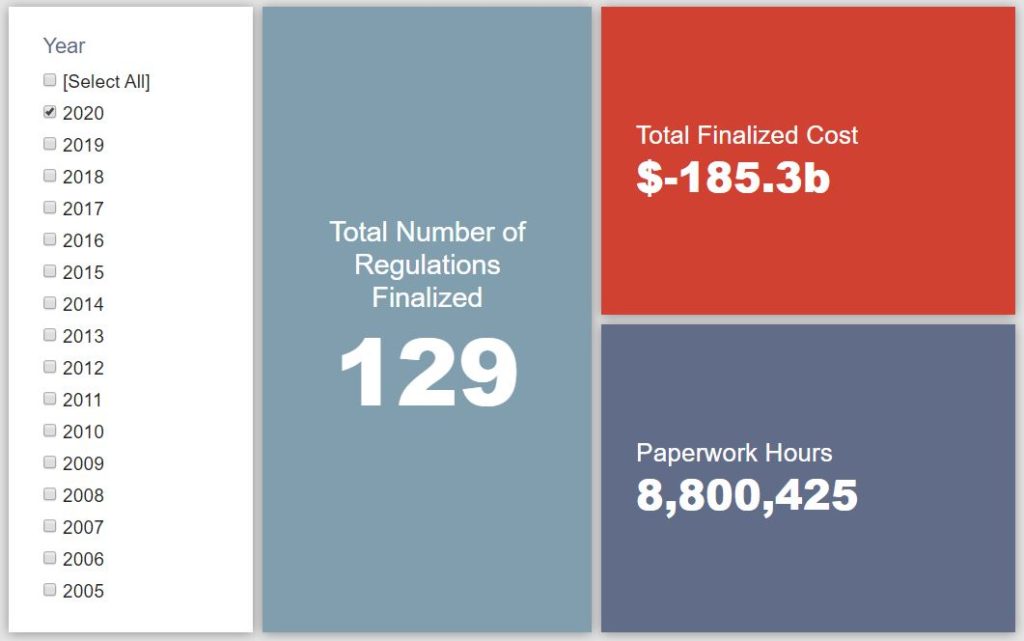Week in Regulation
May 18, 2020
A Busy, Up-and-Down Kind of Week
In one of the more active spates of late, last week saw 16 rulemakings grace the pages of the Federal Register that had some kind of measurable economic impact. A sizable proposed rule from the Securities and Exchange Commission (SEC) accounted for the vast majority of costs. Across the other 15, however, there were net cost reductions of nearly $1.2 billion. Across all rulemakings, agencies published $4.7 billion in total net costs but cut 1.9 million hours of annual paperwork.
REGULATORY TOPLINES
- 2020 Proposed Rules: 51
- 2020 Final Rules: 50
- 2020 Total Pages: 29,549
- 2020 Final Rule Costs: -$185.3 billion
- 2020 Proposed Rule Costs: $8.3 billion
The SEC proposed rule regarding “Good Faith Determinations of Fair Value” led the week in terms of total costs. The proposal seeks to update the procedures involved in determining “the fair value of the investments of a registered investment company or business development company (a ‘fund’).” SEC estimates that such a new framework could present costs of up $5.9 billion. Since this is a proposed rule and SEC is an independent agency, however, these costs do not apply to the fiscal year (FY) 2020 regulatory budget under Executive Order (EO) 13,771.
TRACKING THE REGULATORY BUDGET
The most notable EO 13,771 action of the week was a rule from the Department of Health & Human Services (HHS) regarding the “Adoption and Foster Care Analysis and Reporting System” (AFCARS). The rule pares back certain data collection requirements established under a 2016 AFCARS rule. HHS estimates that this will reduce the reporting burden by roughly 588 thousand annual paperwork hours, reducing annual costs by $26.7 million (yielding roughly $381 million in present value savings).
The Trump Administration expected to reach $51.6 billion in cumulative net savings in FY 2020. To date in the fiscal year, agencies have officially published 81 deregulatory actions and 29 regulatory actions, totaling $186.5 billion in quantified total net cost savings.
THIS WEEK’S REGULATORY PICTURE
This week, a look at how federal agencies have used the terms “coronavirus” and “COVID-19” in their Federal Register notices as the pandemic has unfolded.
May 13 marked two months since President Trump declared the COVID-19 pandemic a national emergency under the Stafford Act. As the length of the pandemic has progressed, federal agencies have increased their usage of COVID-19 over coronavirus.

The graph above tracks the cumulative number of Federal Register actions referencing coronavirus or COVID-19 since the first appearance of either on February 4, when the Department of Homeland Security mentioned coronavirus in a notice regarding flights entering the United States that included passengers that had recently been in China. The World Health Organization officially named the coronavirus COVID-19 on February 11. Coronavirus was used exclusively by federal agencies (albeit in just nine notices) until February 24 when the Centers for Disease Control and Prevention used both terms in the same notice.
The usage rate of coronavirus continued to outpace COVID-19 through March 17. Just nine days later, however, COVID-19 took over the cumulative total lead, helped in large part by the increase in the number of actions referencing the pandemic beginning around St. Patrick’s Day. Through the May 15 edition of the Federal Register, COVID-19 has been used in 268 more actions than coronavirus, with the most lopsided day occurring on April 24, when it was used in 16 more actions than coronavirus. As the graph shows, the usage rate for COVID-19 continues to exceed that of coronavirus, indicating federal agencies are increasingly comfortable using COVID-19 without initially referring to it as a coronavirus.
Of course, most actions reference both terms. Of the 709 actions using COVID-19, 373 also reference coronavirus (with the same number referencing COVID-19 in the 441 actions using coronavirus).
TOTAL BURDENS
Since January 1, the federal government has published $177 billion in total net cost savings (with $185.3 billion from finalized rules) and 22.2 million hours of net annual paperwork burden increases (with 8.8 million hours due to final rules). Click here for the latest Reg Rodeo findings.












